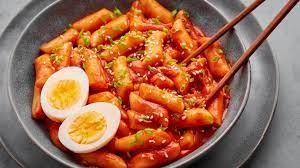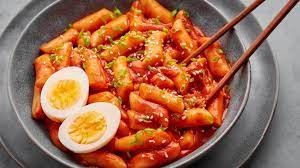Korean cuisine is renowned for its bold flavors, rich history, and diverse range of dishes. Among the myriad of delectable options, one dish stands out for its unique taste and cultural significance – Tteokbokki (떡볶이). In this comprehensive blog post, we’ll delve into the world of Tteokbokki, exploring its history, various types, benefits, storage, recipes, and much more. So, let’s embark on a mouthwatering journey through the world of Tteokbokki!
What is Tteokbokki (떡볶이)?
Tteokbokki, often spelled as ddeokbokki or topokki, is a beloved Korean street food dish that features chewy rice cakes (ddeok) stir-fried in a spicy, savory sauce. While rice cakes are the star of the show, Tteokbokki can also include ingredients like fish cakes, vegetables, and hard-boiled eggs. It’s known for its bold and fiery flavor profile, making it a favorite among spice enthusiasts.

History of Tteokbokki (떡볶이)
The history of Tteokbokki dates back to the late Joseon Dynasty (1392-1910) in Korea. Originally, it was a variation of a dish called “siru tteok,” made by stir-frying rice cakes in soy sauce. Over time, the dish evolved, with the addition of spicy gochujang (red chili paste) becoming a defining characteristic. Tteokbokki gained immense popularity in South Korea during the post-Korean War era, as it was an affordable and filling option for a war-torn nation.
Today, Tteokbokki is a beloved street food snack enjoyed by people of all ages in Korea. It has also gained international recognition, finding its way onto the menus of Korean restaurants worldwide.
Recommended: Kimchi (김치): Korean Cuisine
Various Types of Tteokbokki (떡볶이)
Tteokbokki comes in various regional and modern variations. Here are a few popular types:
- Traditional Tteokbokki: This is the classic version with rice cakes, fish cakes, and a spicy gochujang-based sauce.
- Rabokki: A fusion of ramen and Tteokbokki, this dish includes ramen noodles cooked in the spicy Tteokbokki sauce.
- Gungjung Tteokbokki: A non-spicy version, gungjung Tteokbokki features a soy-based sauce, often garnished with nuts and vegetables.
- Cheese Tteokbokki: This modern twist on Tteokbokki includes a generous amount of cheese that melts into the sauce, creating a creamy and indulgent dish.
Must Read: Kimchi (김치): Korean Cuisine
Benefits of Tteokbokki (떡볶이)
Tteokbokki isn’t just about its delicious taste; it also offers some surprising benefits:
- Rich in Carbohydrates: Tteokbokki provides a good source of carbohydrates from rice cakes, making it an energy-boosting dish.
- Protein from Fish Cakes: If your Tteokbokki includes fish cakes, you get a protein boost as well.
- Spices for Metabolism: The spicy gochujang sauce contains capsaicin, which can help boost metabolism.
- Vegetable Additions: When you add vegetables like cabbage or carrots, you increase the fiber and nutrient content of the dish.
- Comfort Food: Beyond its nutritional value, Tteokbokki is often considered a comfort food that can lift your spirits on a dreary day.
How to Store Tteokbokki (떡볶이)
If you have leftover Tteokbokki, storing it properly is essential to maintain its flavor and texture. Here’s how:
- Refrigeration: Place the Tteokbokki in an airtight container and store it in the refrigerator. It can last for up to 2-3 days.
- Freezing: Tteokbokki can be frozen, but it’s best to freeze the sauce and rice cakes separately. Use freezer-safe containers or bags. It can last for several months in the freezer.
- Reheating: To reheat, gently heat it in a pan on the stovetop or in the microwave. Adding a splash of water can help maintain the sauce’s consistency.
See Also: Kimchi (김치): Korean Cuisine
Recipes of Tteokbokki (떡볶이)
Tteokbokki can be made in various ways to suit your preferences. Here’s a basic recipe:
Ingredients:
- 200g of rice cakes (tteok)
- 100g of fish cakes
- 2 cups of water
- 2 tablespoons of gochujang (Korean red chili paste)
- 1 tablespoon of sugar
- 1 tablespoon of soy sauce
- 1 clove of minced garlic
- 1 green onion, chopped
- 1 boiled egg (optional)
- 1 sheet of roasted seaweed (optional)
Instructions:
- Soak the rice cakes in warm water for about 20 minutes until they become soft.
- In a pan, combine water, gochujang, sugar, soy sauce, and minced garlic. Bring to a boil, then reduce the heat.
- Add the rice cakes and fish cakes to the simmering sauce. Cook until the rice cakes are tender and the sauce thickens (about 10-15 minutes).
- Garnish with chopped green onions and, if desired, a boiled egg and roasted seaweed.
Must Read: Bulgogi (불고기): A Delectable Journey Through Korean Barbecue
What to Do with Tteokbokki (떡볶이)
Tteokbokki is a versatile dish that can be enjoyed in various ways:
- As a Snack: Tteokbokki makes for a satisfying and spicy snack, perfect for munching while watching a movie or sports.
- Side Dish: It can be served as a side dish alongside other Korean dishes like bulgogi or bibimbap.
- Main Course: Tteokbokki can also be a hearty main course when loaded with additional ingredients like vegetables, noodles, or proteins.
- Party Food: Tteokbokki is a hit at parties and gatherings, offering a unique and flavorful option for guests.
- Spicy Comfort Food: Many people turn to Tteokbokki when craving comfort food with a kick.
What to Cook with Tteokbokki (떡볶이)
Pairing Tteokbokki with complementary dishes can create a delightful meal experience. Here are some ideas:
- Kimchi: The tangy and spicy flavors of kimchi complement Tteokbokki’s heat.
- Korean Fried Chicken: The contrast between the crispy fried chicken and the chewy rice cakes is a match made in culinary heaven.
- Pickled Radishes: Sweet and crunchy pickled radishes provide a refreshing contrast to the spiciness of Tteokbokki.
- Kimbap: These Korean rice rolls filled with vegetables, meat, and eggs make for a balanced meal alongside Tteokbokki.
- Korean Pancakes (Jeon): Savory Korean pancakes, such as kimchi jeon or seafood jeon, can be served alongside Tteokbokki for a complete Korean feast.
Recommended: Perilla leaves jangtteok
How to Make Tteokbokki (떡볶이)
While we covered a basic recipe earlier, let’s break down the steps to make Tteokbokki in detail:
Step 1: Prepare the Ingredients
Gather all your ingredients – rice cakes, fish cakes, water, gochujang, sugar, soy sauce, garlic, green onion, boiled egg, and roasted seaweed (optional).
Step 2: Soak the Rice Cakes
Soak the rice cakes in warm water for about 20 minutes or until they become soft. This will help them cook evenly and have the right texture.
Step 3: Make the Sauce
In a pan, combine 2 cups of water, 2 tablespoons of gochujang, 1 tablespoon of sugar, 1 tablespoon of soy sauce, and 1 clove of minced garlic. Stir well and bring the mixture to a boil.
Step 4: Cook the Tteokbokki
Add the soaked rice cakes and fish cakes to the simmering sauce. Cook over medium heat, stirring occasionally, until the rice cakes are tender and the sauce thickens. This should take about 10-15 minutes.
Step 5: Garnish and Serve
Once the Tteokbokki is ready, garnish it with chopped green onions. You can also add a boiled egg and a sheet of roasted seaweed for extra flavor and presentation. Serve hot and enjoy!
Must read: Bibimbap (비빔밥): Exploring the Delicious World of Korean cuisine
Tteokbokki (떡볶이) Ingredients
The key ingredients in Tteokbokki are:
- Rice Cakes (Tteok): These chewy, cylindrical rice cakes are the star of the dish.
- Fish Cakes: Thin slices of fish cakes add texture and flavor.
- Gochujang: Korean red chili paste provides the signature spiciness.
- Sugar: Adds a touch of sweetness to balance the heat.
- Soy Sauce: Enhances the savory flavor of the sauce.
- Garlic: Adds depth and aroma to the sauce.
- Green Onions: Used for garnish and a mild onion flavor.
- Boiled Egg: An optional addition for extra protein and creaminess.
- Roasted Seaweed: Optional for a unique taste and presentation.
Nutrition in Tteokbokki (떡볶이)
Tteokbokki’s nutritional profile can vary depending on the ingredients and portion size. Here’s a general overview:
- Calories: A typical serving of Tteokbokki contains around 300-400 calories.
- Carbohydrates: The primary source of calories in Tteokbokki comes from carbohydrates, mainly from rice cakes and sauce.
- Protein: The addition of fish cakes and eggs can provide a moderate amount of protein.
- Fat: Tteokbokki is relatively low in fat, with most of the calories coming from carbohydrates.
- Fiber: The dish contains minimal fiber unless you add vegetables.
- Vitamins and Minerals: Tteokbokki doesn’t provide significant amounts of vitamins and minerals unless you incorporate nutrient-rich vegetables.
See Also: Samgyeopsal (삼겹살): A Delicious Korean Cusine
FAQs
1. Is Tteokbokki gluten-free?
Traditional Tteokbokki made with rice cakes is naturally gluten-free. However, it’s essential to check the labels of ingredients like fish cakes and sauces for any hidden gluten.
2. How spicy is Tteokbokki?
The level of spiciness can vary depending on personal preferences and the amount of gochujang used. It can range from mildly spicy to extremely hot, so adjust the spice level to your liking.
3. Can I make Tteokbokki without gochujang?
While gochujang is a fundamental ingredient in Tteokbokki, you can make a non-spicy version by substituting it with soy sauce or a soy-based sauce.
4. Is Tteokbokki healthy?
Tteokbokki can be a part of a balanced diet when enjoyed in moderation. Adding vegetables and lean proteins can enhance its nutritional value.
Conclusion
Tteokbokki, with its rich history and tantalizing flavors, is a testament to the culinary excellence of Korean cuisine. Whether you savor the classic spicy version or explore its diverse regional adaptations, Tteokbokki promises a delightful gastronomic experience. From its humble beginnings on the streets of Korea to international acclaim, this beloved dish continues to captivate taste buds worldwide. So, the next time you’re in the mood for a spicy and satisfying treat, consider indulging in the savory world of Tteokbokki.
Recommended: Japchae (잡채): A Delicious Journey into Korean Cuisine

